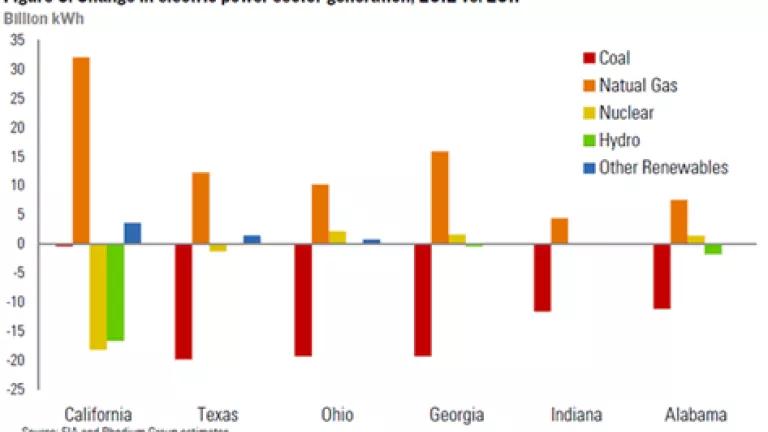
The California Air Resources Board released emissions reports today from the state’s largest carbon polluters in 2012. Contrary to national trends, the numbers show a sharp increase in emissions from the power sector relative to the year before. With the nation’s most ambitious climate and clean energy law, the Global Warming Solutions Act (AB 32), in effect, the numbers beg the question – why is California seemingly moving in the opposite direction?
While it’s said numbers never lie, they can be deceiving. Unpacking the emissions reports reveals two predominant factors behind the emissions increase from 2011 to 2012:
- The abrupt shutdown and subsequent retirement of the San Onofre Nuclear Generating Station (SONGS) in Southern California (meaning less of California’s power in 2012 came from emissions-free nuclear power); and
- A relatively ‘dry’ hydro year compared to 2011 (meaning less of California’s power in 2012 came from emissions-free hydropower)
But the real takeaway is those factors will not prevent California from achieving its carbon reduction targets. The state’s clean energy policies are designed to account for precisely this type of uncertainty and year-to-year fluctuation to ensure emissions continue to fall over time.
SONGS Shutdown
SONGS went out of service in January 2012, so this is the first time the impact of the giant nuclear plant’s shuttering shows up in California’s emissions data. At 2,200 megawatts, the plant was one of the largest power plants in the state (equivalent to four typical large power plants), and provided zero-emissions power throughout Southern California day and night. Replacing SONGS’ capacity and voltage support to the region has been a major undertaking for California’s energy agencies, utilities and grid planners ever since Southern California Edison announced it was permanently closing the plant last June.
In the long run, the good news is the state has announced plans to meet over half of SONGS’ lost output through increased energy efficiency and renewables. And all of the state’s power sector emissions are subject to mandatory limits under California’s cap-and-trade program. But in the short term, the plant’s output has largely been replaced with natural gas, which – while roughly half as emissions-intensive as coal – led to a significant uptick in California’s power sector emissions in 2012 relative to the nuclear power it displaced (and will again in 2013).
Hydropower Variability
The second key factor behind the rise in California’s power-sector emissions in 2012 was a sharp decline in hydropower generation due to a relatively ‘dry’ year. Annual rainfall contributes significantly to the amount of California’s hydropower each year, which in turn has significant impacts on the power sector’s overall carbon emissions. The state experienced the opposite effect in 2011 on the heels of a particularly ‘wet’ year, which contributed to a 30% drop in power sector emissions relative to 2010.
These year-to-year fluctuations reinforce both the need to evaluate emissions performance over a longer time period and to design policies accordingly. Thankfully, California’s cap-and-trade program is designed to do just that. The program employs a series of flexible compliance strategies like emissions allowance ‘banking’ and three-year compliance periods to accommodate yearly fluctuations in weather patterns, fuel prices, and other variables that impact short-term emission levels, while providing long-term certainty that California’s carbon pollution will steadily decline through a hard cap on emissions.
Looking Ahead
At first glance the 2012 emissions trends in California’s power sector appear troubling for a state long recognized as a leader on climate and clean energy. Digging deeper, however, reveals the state’s policies are designed to prevent the very factors that precipitated the uptick in emissions in 2012 from altering the state’s long-term downward trajectory. Over the long run, the performance of those policies will tell the real story of California’s progress in reducing carbon pollution.
